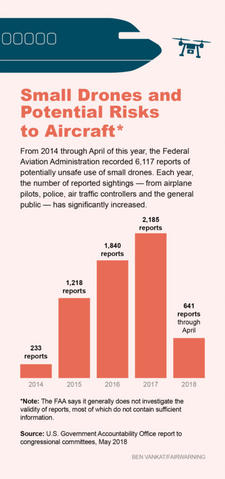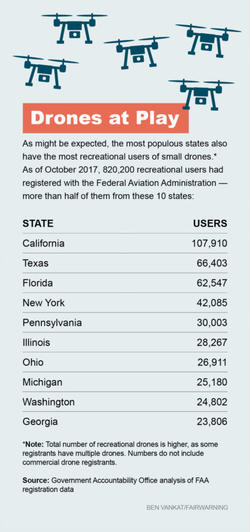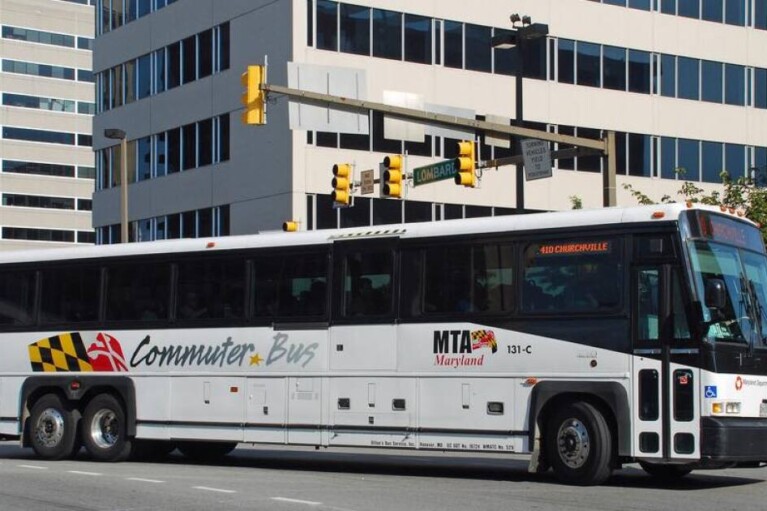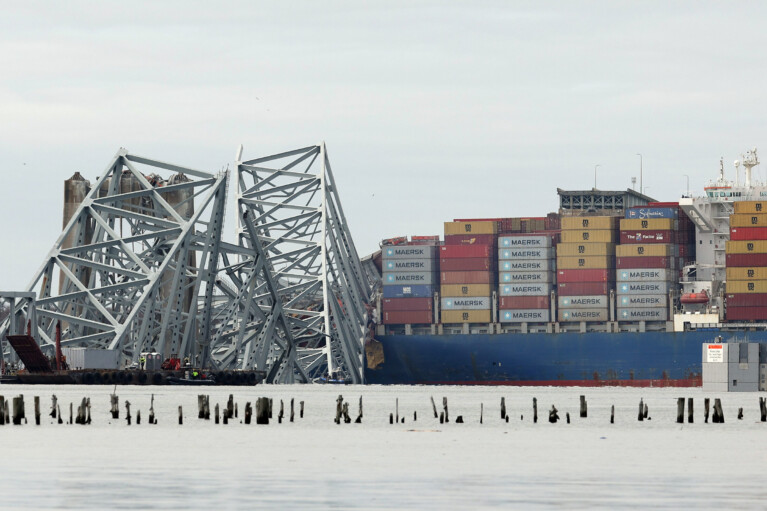Amid Dramatic Growth of U.S. Drone Fleet, Federal Safety Oversight Lags
As the nation’s fleet of small recreational and commercial drones keeps soaring — the government projects nearly 3 million will be in the skies by 2022 — safety concerns are rising even as federal enforcement stalls
In Maryland, there are 15,544 registered recreational unmanned aircraft systems users and 1,983 registered commercial UAS users, according to a recent report by the Government Accountability Office.
Nationwide, the Federal Aviation Administration has collected 6,117 reports of potentially unsafe use of drones from February 2014 through April 2018, the GAO found.
What’s more, an FAA-industry working group wrote in December that, while most of the incidents don’t appear to be serious, “There is general consensus that some of the sightings are potentially high risk.”
Yet few of these reports have been investigated and, in 2016 and 2017, just 32 incidents resulted in any enforcement action, an FAA spokesman told FairWarning.

The FAA, in defending its practices, points out that investigations face big obstacles: Drones are not customarily detected by radar, there usually is no physical evidence to recover and it’s generally not clear who the drone operators are. Still, the FAA, responding to the GAO’s call in its May report for the agency to help “determine whether additional actions are needed to ensure the safety of the national airspace,” agreed it could strengthen its efforts.
The FAA said in an email to FairWarning that it was “very proud of our safety record,’’ but that agency officials “appreciate the GAO’s recommendation.”
The situation worries safety advocates.
“I hate to say it, but it’s been proven over and over — the safety agencies don’t usually act until there’s blood on the ground,” said Paul Hudson, president of FlyersRights.org, an airline passenger advocacy group. “Without some changes, I’m afraid we’re just waiting for the first disaster to occur.”
There already have been collisions that highlight the risks. The GAO noted that last September a drone collided with an Army helicopter near New York’s Staten Island, and the following month a drone collided with a passenger plane in Canada. The FAA also received a report of a person on the ground being struck by a drone and losing consciousness.
Some of the FAA’s enforcement actions have simply led to the agency issuing warning letters or counseling drone operators on how to comply with safety results. Only one case since 2016, the GAO report said, has led to a penalty, which amounted to $9,700.
By far the largest civil penalty the FAA ever collected from a drone operator stemmed from a case against SkyPan International Inc. The FAA accused the Chicago-based company of conducting 65 unauthorized commercial aerial photography flights over restricted airspace in New York City and Chicago between 2012 and 2014.
The agency proposed a $1.9 million fine in late 2015, saying SkyPan operated in a reckless manner. In early 2017, the FAA announced that the case had been settled for $200,000.
Small drones, which range in weight from about a half-pound to just under 55 pounds, are generally prohibited from flying in the U.S. above 400 feet, over people or near airports without prior authorization.

The FAA estimates that at least 1.7 million small drones are being operated in the U.S. That’s more than five times higher than the number of manned aircraft. And, in 2022, the drone total is projected to reach 2.9 million.
Meanwhile, reports of potentially hazardous sightings also are climbing. In 2014, the GAO said, there were 233 such reports; in 2017, there were 2,185.
“Anytime there are more operating, the risk goes up,” said University of Michigan aerospace engineering professor Ella Atkins. “So the risk absolutely is going up.”
The FAA website provides summaries of drone incidents – or “sightings,” as the agency calls them – reported by aircraft pilots, air traffic controllers, law enforcement officials and others. On one randomly chosen day, March 31, there were seven reports overall, coming from such places as New York City, San Jose, Calif., and Pendleton, Ore. They included sightings of drones well above 400 feet, near airports or in landing routes. The Oregon case involved a drone that reportedly crashed and burned on the north side of an airport, starting a two-acre brush fire. In the San Jose case, a two-foot diameter drone allegedly passed within 100 feet of an aircraft.
In addition, such federal agencies as the Department of Defense and the Bureau of Prisons have recorded multiple incidents of drones flying over their property or otherwise interfering with their operations.
In testimony before a congressional hearing last year, defense officials said that unauthorized drone flights over Navy and Air Force installations “represent a growing threat to the safety and security of nuclear weapons and personnel.” Military agencies reported 128 incidents in a two-year period beginning in January 2015.
Federal correctional officials, for their part, reported seven incidents of unmanned vehicles dropping contraband into prisons from November 2015 through December 2017.
Meanwhile, the FAA “continues to open U.S. skies” to civilian use, unlike agencies in many other countries, according to The Center for the Study of the Drone at Bard College.
In its 2017 year in review, the center reported that the FAA granted 1,169 waivers for drone operations that would otherwise have been prohibited because of, among other things, the 400-foot altitude restriction and rule against flying near airports. Examples: The first-ever permission for a robotic firm to operate a drone at Atlanta’s busy international airport, and an agreement for CNN to fly drones over people.
Two years ago, the FAA’s funding bill included a requirement that drone manufacturers provide information about regulations in their product packaging. In addition, the maximum fines were raised to $20,000 for drone operators who interfere with law enforcement, emergency response or wildfire-fighting operations. The bill also directed the FAA to continue work on a system to integrate drones into the nation’s airspace.
But legislative proposals to enable the FAA to require drone manufacturers to install crash avoidance systems and other safety features in their unmanned airborne vehicles never got very far.
The 2018 FAA reauthorization bill, recently approved in the House and now awaiting Senate action, calls for the FAA to coordinate with NASA on airborne collision research. But it would also prevent the FAA from establishing new regulations for drones operating at less than 400 feet that are not interfering with manned aircraft or flying within five miles of an airport.
The FAA says it is now considering requiring drones to have remote tracking ID systems. “In the future,” the FAA told the GAO, “we expect that remote identification will help significantly.”
That’s an idea that some industry groups say makes sense.
“The potential increase in safety risks that are highlighted in the GAO report underscores the urgent need to equip all [drones] with remote identification technology,” Brian Wynne, president of the Association for Unmanned Vehicle Systems International, whose membership includes many drone makers, said in an email. “In addition to quickly identifying, tracking, and apprehending careless and reckless operators, remote identification will help pave the way for expanded [drone] operations, such as flights over people and beyond line of sight.”
Last December’s report by the Unmanned Aircraft Safety Team, the FAA-industry partnership established to analyze the agency’s system for reporting drone incidents, reviewed 3,417 sighting reports from August 2015 through March 2017. It found that in 16 percent of the cases, the drone was described as being less than 500 feet away from a manned aircraft, and that 3 percent of the incidents, “resulted in the manned aircraft changing flight or course.”
The report’s recommendations mainly called for improving record-keeping and continuing with education programs for pilots and drone operators. The report also expressed confidence that new technology, including remote identification systems, “will improve airspace integration.”
Atkins, the aerospace engineering professor, says the FAA also should reach out to local law enforcement agencies to improve safety oversight.
“The FAA has a problem enforcing safety policy because over the course of its history, it always had the power of dealing with issues once planes landed — air traffic control would tell you to call the tower when you land,” she said.
With drones, she added, “we’re in a period of confusion. The FAA says, ‘We own the skies,’ but it is not making appropriate connections with state and law enforcement – because it has to be the people on the ground, the city and state police, that have to go and deal with the impact of the drones operating near the ground.”
This story was produced by FairWarning, a nonprofit news organization based in Pasadena, Calif., that focuses on public health, consumer and environmental issues. Like Maryland Matters, FairWarning is a member of the Institute for Nonprofit News.



 Creative Commons Attribution
Creative Commons Attribution